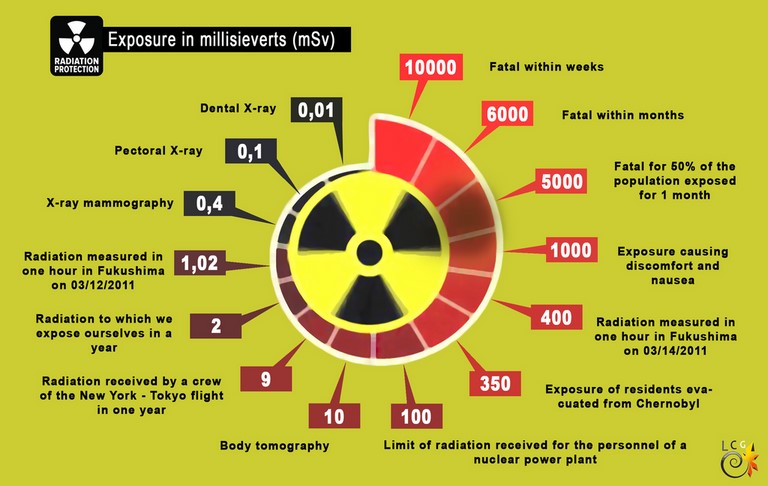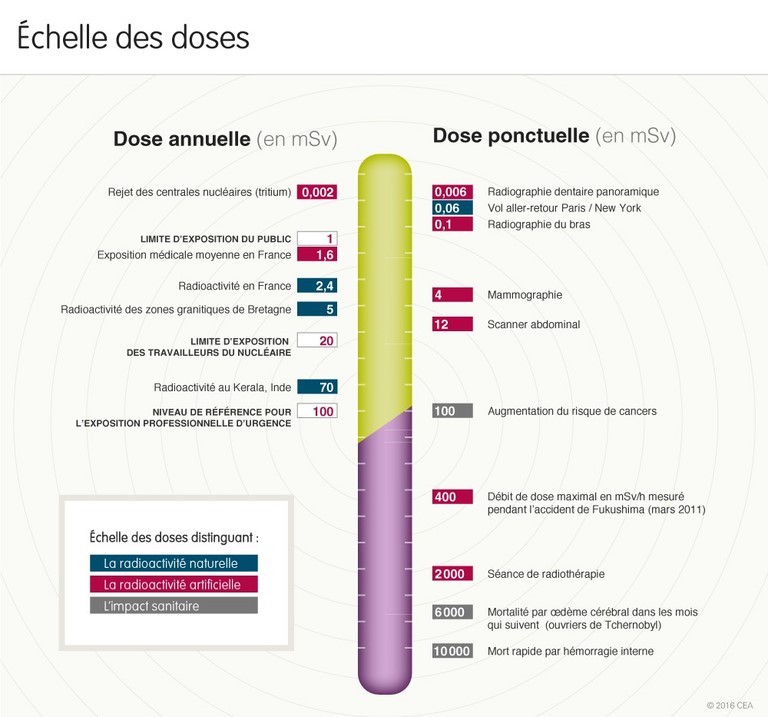 What is radioactivity ?
What is radioactivity ?
Radioactivity : definition
Radioactivity is the property of certain atomic nuclei to lose part of their mass by emitting particles (alpha or beta), and/or electromagnetic radiation (gamma). This loss of mass (or disintegration) continues in a chain until stable compounds are obtained.
Minerals containing uranium or thorium are radioactive, with an intensity proportional to the quantity of radioactive metals present (uraninite, autunite, thorianite, torbernite...).
Many weakly radioactive minerals (fergusonite, allanite, zircon...), although emitting little radiation, nevertheless show a strong disorganization of their network caused by X-rays. Highly radioactive minerals do not undergo this metamict disorganization, the strongly ionic atomic bonds of these minerals ensuring rapid restoration of damage caused by irradiation.
Minerals containing uranium or thorium are radioactive, with an intensity proportional to the quantity of radioactive metals present (uraninite, autunite, thorianite, torbernite...).
Many weakly radioactive minerals (fergusonite, allanite, zircon...), although emitting little radiation, nevertheless show a strong disorganization of their network caused by X-rays. Highly radioactive minerals do not undergo this metamict disorganization, the strongly ionic atomic bonds of these minerals ensuring rapid restoration of damage caused by irradiation.
Measuring the radioactivity of minerals
The activity of a source is measured in units of transformations per second, called becquerel (Bq) = 1/s in the International System. The old unit is the curie (Ci), which is equivalent to the number of transformations per second in a gram of 226Ra, or 3.7×1010 transformations per second.
The Sievert (Sv) is the unit used to assess the impact of ionizing radiation on humans. It is the unit of the International System which takes into account the biological effects on living tissues produced by absorbed radiation. In this way, the equivalent dose is obtained through the absorbed dose multiplied by two appropriate dimensionless weighting factors.
The activity and impact of ionizing radiation can be measured using a Geiger counter which will display a value in µSv/h (microsieverts per hour). 1mSv = 1000µSv.
The Sievert (Sv) is the unit used to assess the impact of ionizing radiation on humans. It is the unit of the International System which takes into account the biological effects on living tissues produced by absorbed radiation. In this way, the equivalent dose is obtained through the absorbed dose multiplied by two appropriate dimensionless weighting factors.
The activity and impact of ionizing radiation can be measured using a Geiger counter which will display a value in µSv/h (microsieverts per hour). 1mSv = 1000µSv.
Dangers of radioactivity
The world's population is constantly subjected to doses of ionizing radiation from natural sources. These sources can be classified into two types; cosmic rays, coming from space and whose exposure depends on the altitude and latitude of the person, as well as the radiation emitted by radionuclides naturally present on Earth. In 2008, the average annual dose received by the world population was 2.4 mSv. This dose varies depending on the regions and their geologies, so the granites of Brittany or the Massif Central in France generate annual doses of around 5 mSv. But there are also artificial sources. In France, the exposure limit for nuclear workers is set at 20 mSv. The increased risk of cancer increases by 5% as soon as the annual dose exceeds 100 mSv.
Relative dangers of mineral radioactivity
In France and Europe, the possession of radioactive minerals is not subject to any declaration obligation, neither for individuals nor for museums. However, handling, mining, or collecting minerals necessarily results in exposure to radioactive material. In order to put into perspective the impact that this exposure can have on human health, we have carried out some measurements.
The most radioactive sample we found in our stock is a cuproskodowskite from Katanga. Our Geiger counter placed very close to the sample outside its box displays a radioactivity of 225 µSv/h, this radioactivity is only 2.5 µSv/h at 50 cm from its closed plastic box and the ambient radioactivity of the room (which contains other radioactive minerals such as autunites or torbernites) and 0.30 µSv/h.
By arbitrarily setting an annual exposure threshold at 10 mSv (2 times lower than that of a nuclear worker), you would have to keep the sample with you for around 2 full days to reach this threshold, or stay 166 days 24 hours a day to 50 cm from the box. In absolute terms, there is therefore no danger in having radioactive minerals in a display case or in a box.
The most radioactive sample we found in our stock is a cuproskodowskite from Katanga. Our Geiger counter placed very close to the sample outside its box displays a radioactivity of 225 µSv/h, this radioactivity is only 2.5 µSv/h at 50 cm from its closed plastic box and the ambient radioactivity of the room (which contains other radioactive minerals such as autunites or torbernites) and 0.30 µSv/h.
By arbitrarily setting an annual exposure threshold at 10 mSv (2 times lower than that of a nuclear worker), you would have to keep the sample with you for around 2 full days to reach this threshold, or stay 166 days 24 hours a day to 50 cm from the box. In absolute terms, there is therefore no danger in having radioactive minerals in a display case or in a box.
So, be careful...
The disintegration of radionuclides present in minerals increases the level of natural ambient radioactivity, particularly radon gas. It is therefore necessary to store these minerals in properly ventilated spaces. Handling the most friable rocks and minerals can also create a risk of internal exposure in the event of inhalation or ingestion of dust, thereby considerably increasing exposure to the most vulnerable internal parts of the body. It is therefore preferable to wash your hands thoroughly after handling but also not to crush, break with a hammer or polish these specimens. Powdered radioactive minerals can be stabilized with paraloid B72, a reversible plasticizer used by museums. This treatment does not remove the radioactivity but prevents the sample from emitting fine radioactive particles.
In the event of a health risk, the Nuclear Safety Authority (ASN) can contact the IRSN to secure the premises. The IRSN can mobilize, via the Radioprotection Intervention and Assistance Service (SIAR), a team of engineers and technicians throughout France in a few hours. To do this, the SIAR has equipment for sampling, measuring and protecting people. Furthermore, the National Agency for Radioactive Waste Management (Andra) can be contacted if it proves necessary to evacuate all or part of the minerals. Finally, the IRSN intervenes when a radioactive mineral is detected by a load control gantry like those found at the entrance to recycling centers. This happened in 2013, at the French entrance to the Channel Tunnel, for a German postal package containing a radioactive mineral. However, this type of alert is rarely due to a collection mineral, which has "low" radioactivity...
In the event of a health risk, the Nuclear Safety Authority (ASN) can contact the IRSN to secure the premises. The IRSN can mobilize, via the Radioprotection Intervention and Assistance Service (SIAR), a team of engineers and technicians throughout France in a few hours. To do this, the SIAR has equipment for sampling, measuring and protecting people. Furthermore, the National Agency for Radioactive Waste Management (Andra) can be contacted if it proves necessary to evacuate all or part of the minerals. Finally, the IRSN intervenes when a radioactive mineral is detected by a load control gantry like those found at the entrance to recycling centers. This happened in 2013, at the French entrance to the Channel Tunnel, for a German postal package containing a radioactive mineral. However, this type of alert is rarely due to a collection mineral, which has "low" radioactivity...


